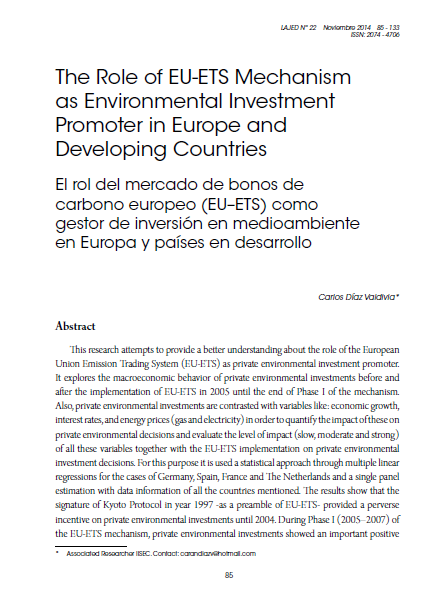The role of EU-ETS Mechanism as Environmental Investment Promoter in Europe and Developing Countries
DOI:
https://doi.org/10.35319/lajed.20142282Keywords:
EU-ETS, investment, environment, clean development mechanism, MDLAbstract
This research attempts to provide a better understanding about the role of the European Union Emission Trading System (EU-ETS) as private environmental investment promoter. It explores the macroeconomic behavior of private environmental investments before and after the implementation of EU-ETS in 2005 until the end of Phase I of the mechanism. Also, private environmental investments are contrasted with variables like: economic growth, interest rates, and energy prices (gas and electricity) in order to quantify the impact of these on private environmental decisions and evaluate the level of impact (slow, moderate and strong) of all these variables together with the EU-ETS implementation on private environmental investment decisions. For this purpose it is used a statistical approach through multiple linear regressions for the cases of Germany, Spain, France and The Netherlands and a single panel estimation with data information of all the countries mentioned. The results show that the signature of Kyoto Protocol in year 1997 -as a preamble of EU-ETS- provided a perverse incentive on private environmental investments until 2004. During Phase I (2005–2007) of the EU-ETS mechanism, private environmental investments showed an important positive recovery that was not enough to reach pre Kyoto Protocol levels. Finally, it is analyzed the investment in developing countries through CDM projects.
Downloads
References
Barret, J., (2009). Arguments for Auctioning Carbon Permits. Clean Economy Development Center for Economics for Equity and the Environment Network.
Blanco, M. & G. Rodrigues (2008). “Can the future EU-ETS support wind energy investments?” Energy Policy, 36(4), 1509-1520.
Chatterjee, S. (1988). Sensitivity Analysis in Linear Regression. Wiley, First Edition.
Chester, L. & S. Rosewarne (2011). What is the relationship between derivative markets and carbon prices? Australian Political Economy. Department of Political Economy, University of Sydney.
Chevallier, J. (2012). Econometric Analysis of Carbon Markets: The European Union Emissions Trading Scheme and the Clean Development Mechanism. Springer Netherlands.
Dornbusch, R. & S. Fischer (2004). Macroeconomía. España: McGraw-Hill. 9º ed.
Ellerman, D. & P. Joskow (2008). The European Emission’s Trading System in Perspective. MIT Center for Energy and Environmental Policy Research.
European Commission (2005). EU action against climate change: EU emission trading – an open scheme promoting global innovation. European Communities.
Feilhauer, S. (2009). “Impact of European Emissions Trading System (EU-ETS) on Carbon Emissions and Investment Decisions in the Power Sector.” Massachusetts Institute of Technology (Master Thesis).
Graus, W., U. Sreenivasamurthy & B. Wesselink, (2009). EU climate policy impact in 2020 - With a focus on the effectiveness of emissions trading policy in an economic recession scenario. Ecofys.
Gudbrandsdottir, H. (2011). “Predicting the Price of EU ETS Carbon Credits: A Correlation, Principal Component and Latent Root Approach.” Reykjavík University, Iceland (Master Thesis).
Hoffman, V. (2007). EU ETS and Investment Decisions: The Case of the German Electricity Industry. European Management Journal, 25(6), 464-474.
Koenig, P. (2011). “Modelling Correlation in Carbon and Energy Markets.” Electricity Policy Research Group, Working Paper 1107 and Cambridge Working Paper in Economics 1123
Kossoy, A. & F. Ambrosi (2012). “State and Trends of the Carbon Markets.” Carbon Finance at World Bank.
Kumar, K. (2011). “Carbon Trading. Dissemination Paper Series. Centre of Excellence in Environmental Economics”. Madras School of Economics.
Lacombe, R. (2008). “Economic Impact of the EU-ETS: Evidence from the refining sector”. Massachusetts Institute of Technology (Master Thesis).
Larrain, F. & J. Sachs (2002). Macroeconomía en la economía global. Pearson Education, 2º edition.
Leguet, B. (2012). “Understanding the Link between Macroeconomic Environment and the EU Carbon Price”. Newsletter Nº 66, CDC Climat Research.
Milunovich, G. & R. Joyeux (2007). “The Temporal Links Between Spot and Futures Carbon Allowance Markets”. Division of Economic and Financial Studies Macquarie University.
North, D. (1990). “Institutions, Institutional Change and Economic Performance”. Cambridge University Press.
Obermayer, J., (2010). “An analysis of the fundamental price drivers of EU ETS carbon credits”. Royal Institute of Technology (Master Thesis).
Rogge, K. & M. Schneider (2010). “The innovation impact of the EU Emission Trading System. Findings of company case studies in the German power sector.” Ecological Economics, 70(3), 513-523.
Rogge, K. & V. Hoffman (2010). “The impact of the EU ETS on the sectoral innovation system for power generation technologies. Findings for Germany”. Energy Policy, 38(12), 7639-7652.
Schuttelaar, F. (2012). “Correlation between Carbon and Energy Markets”. Presentation at Workshop HEC Energy and Finance Chair. GDF SUEZ Trading.
Stern, N. (2007). The Economics of Climate Change: The Stern Review. Cambridge University Press.
Venmans, F. (2012). “A literature-based multi-criteria evaluation of the EU ETS.” Renewable and Sustainable Energy Reviews, 16(8), 5493-5510.
Zhang, Y. & Y. Wei (2010). “An overview of current research on EU ETS: Evidence from its operating mechanism and economic effect.” Applied Energy, 87(6), 1804-1814.






